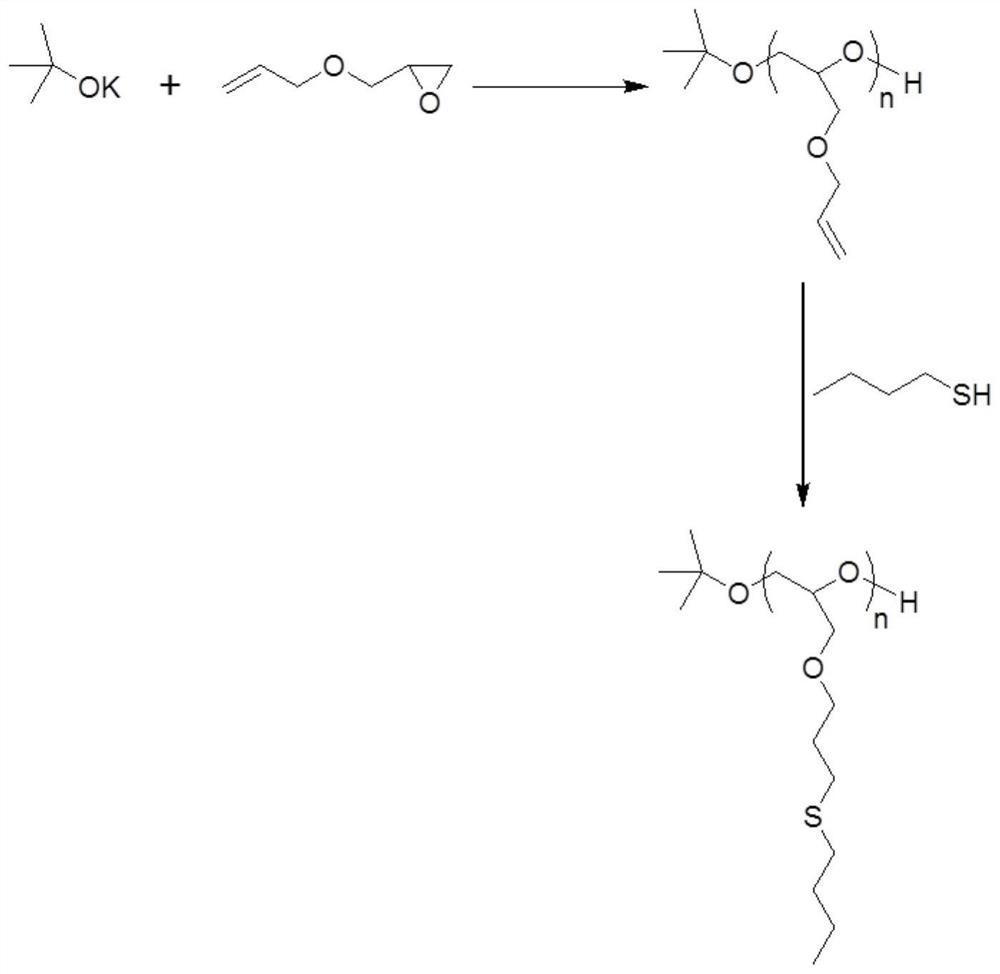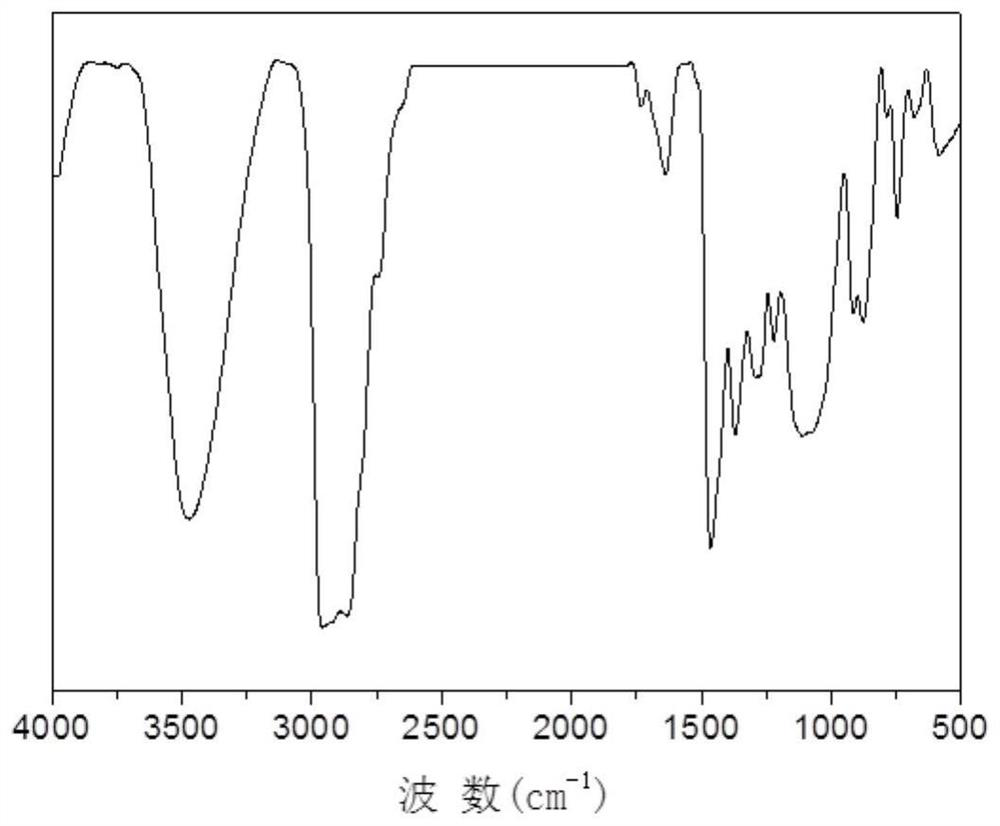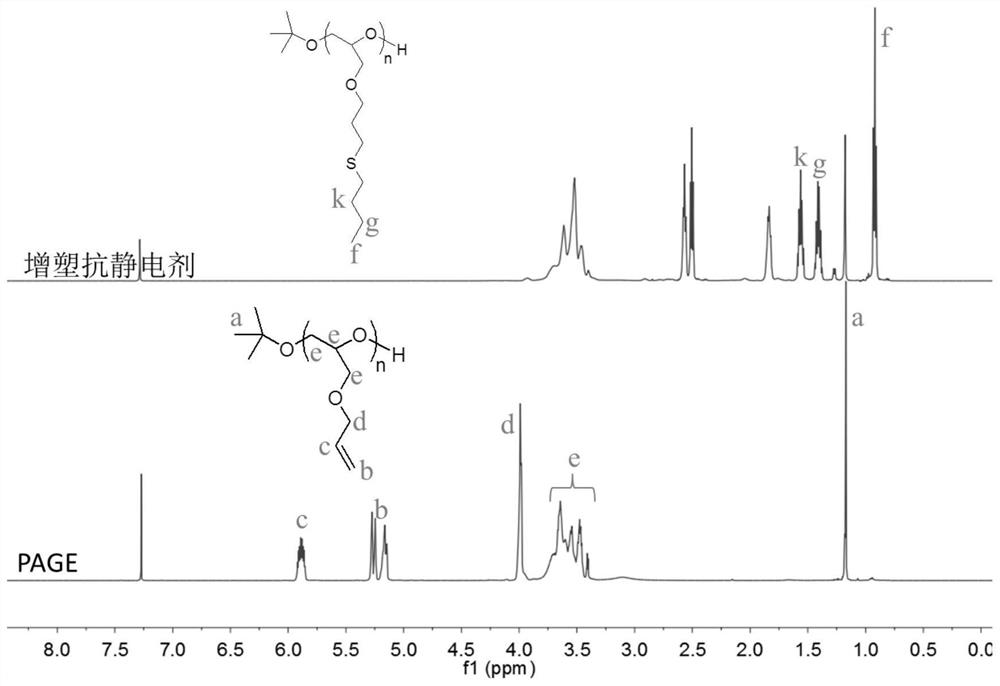Polyvinyl chloride plasticizing antistatic agent and preparation method thereof
A technology of polyvinyl chloride and plasticizing resistance, which is applied in the field of fine chemical additives, can solve the problems of high energy consumption in the preparation process, high investment in equipment, and single function, so as to save the cost of adding additives, ensure quality stability, reduce The effect of the process
- Summary
- Abstract
- Description
- Claims
- Application Information
AI Technical Summary
Problems solved by technology
Method used
Image
Examples
Embodiment 1
[0030] This embodiment provides a polyvinyl chloride plasticized antistatic agent, which is prepared by the following method:
[0031] (1) Dissolve 0.6 g of potassium tert-butoxide and 6 g of allyl glycidyl ether in anhydrous tetrahydrofuran. The solution was polymerized at 60°C for 24 hours. After that, hydrochloric acid was added to the system to terminate the polymerization reaction. The precipitate was removed by filtration. The organic solvent was removed by a rotary evaporator to obtain the intermediate product of polyallyl glycidyl ether (PAGE).
[0032] (2) 2.5 g of the above intermediate product PAGE, 4 g of n-butanethiol, 8.12 mg of terpyridyl ruthenium chloride and 73.63 mg of p-toluidine were dissolved in N-methylpyrrolidone. The solution was left at room temperature and irradiated with blue light for 0.5 h to complete the reaction. After the reaction, unreacted n-butanethiol, solvent and catalyst were removed by dialysis in ethanol. Ethanol is removed by rota...
Embodiment 2
[0034] This embodiment provides a polyvinyl chloride plasticized antistatic agent, which is prepared by the following method:
[0035] (1) Dissolve 0.6 g of potassium tert-butoxide and 3 g of allyl glycidyl ether in anhydrous tetrahydrofuran. The solution was placed at 60°C for 2 hours to polymerize. After that, sulfuric acid was added to the system to terminate the polymerization reaction. The precipitate was removed by filtration. The organic solvent was removed by a rotary evaporator to obtain the intermediate product of polyallyl glycidyl ether (PAGE).
[0036] (2) 2.5 g of the above-mentioned intermediate product PAGE, 2 g of n-butanethiol, 8.12 mg of terpyridyl ruthenium chloride and 73.63 mg of p-toluidine were dissolved in N,N-dimethylformamide. The solution was left at room temperature and irradiated with blue light for 0.5 h to complete the reaction. After the reaction, unreacted n-butanethiol, solvent and catalyst were removed by dialysis in ethanol. Ethanol is...
Embodiment 3
[0038] This embodiment provides a polyvinyl chloride plasticized antistatic agent, which is prepared by the following method:
[0039] (1) Dissolve 0.6 g of potassium tert-butoxide and 60 g of allyl glycidyl ether in anhydrous toluene. The solution was placed at 40°C for 24 hours to polymerize. After that, phosphoric acid was added to the system to terminate the polymerization reaction. The precipitate was removed by filtration. The organic solvent was removed by a rotary evaporator to obtain the intermediate product of polyallyl glycidyl ether (PAGE).
[0040] (2) 2.5 g of the above intermediate product PAGE, 5 g of n-butanethiol, 8.12 mg of terpyridyl ruthenium chloride and 73.63 mg of p-toluidine were dissolved in ethanol. The solution was left at room temperature and irradiated with blue light for 2 hours to complete the reaction. After the reaction, unreacted n-butanethiol, solvent and catalyst were removed by dialysis in ethanol. Ethanol is removed by rotary evapora...
PUM
| Property | Measurement | Unit |
|---|---|---|
| elongation at break | aaaaa | aaaaa |
Abstract
Description
Claims
Application Information
 Login to View More
Login to View More - R&D
- Intellectual Property
- Life Sciences
- Materials
- Tech Scout
- Unparalleled Data Quality
- Higher Quality Content
- 60% Fewer Hallucinations
Browse by: Latest US Patents, China's latest patents, Technical Efficacy Thesaurus, Application Domain, Technology Topic, Popular Technical Reports.
© 2025 PatSnap. All rights reserved.Legal|Privacy policy|Modern Slavery Act Transparency Statement|Sitemap|About US| Contact US: help@patsnap.com



